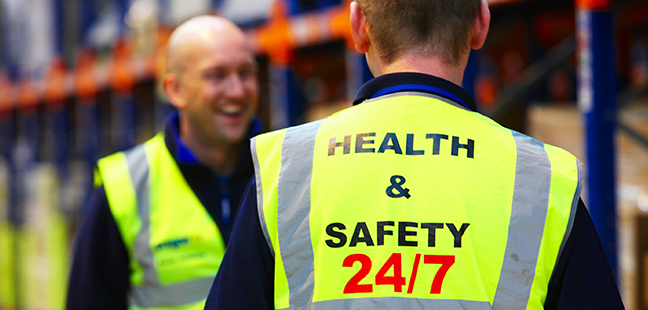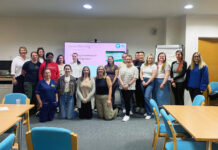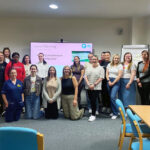European Health and Safety Week takes place in October each year and is designed to raise awareness of health and safety at work. Every year more than 5,000 people lose their lives in the EU as a result of accidents in the workplace. A great many of these lives could be saved and many thousands of other injuries prevented if risks were anticipated and sensible safety measures implemented.
According to Peter Mackie, NHS Forth Valley’s Head of Health and Safety, managing health and safety is everyone’s business – whether it be learning how to lift patients correctly, tackling possible outbreaks of fire or making sure you are well versed in infection control. With this in mind, NHS Forth Valley has set out a three year plan to ensure that health and safety is high on everyone’s agenda. This will include:
- A set of health and safety principles that lay out what we as an organisation expect staff to adhere to. These are supported by the Chief Executive and Chairman and set the tone for how health and safety should be managed.
- Completing a self-assessed review by local managers regarding their health and safety management process. This will provide a measure of where wards and departments are in relation to compliance
- Agreeing the training requirements for all managers within NHS Forth Valley and look towards training requirements for all staff. There will be a target of every service having at least one manager who has completed a health and safety course such as the Institution of Occupational Safety and Health (IOSH) course
- Setting targets to increase the number of frontline staff who have completed the risk assessment and adverse event investigation training. This is to ensure we manage adverse events appropriately and learn from the investigations.
- Trialling the provision of face-to-face health and safety updates (twice per year) to ensure all staff are updated on current health and safety issues. We currently produce written information in hard copy and online but we will trial some face-to-face sessions and measure the response and effect.
- Plans to update and revise the eRSM system. We are currently working with the Ulysses Company who are designing a module within our Safeguard system that will make health and safety management recording much easier for all staff. Regular progress reports will be issued to keep staff up-to-date with how this work is developing.
- Recognising good practice – work will be undertaken to shine the spotlight on areas across the organisation which are skilled in incorporating safety standards into everyday work practice.
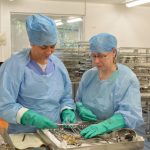 THINK SAFE BY BEING CLEAN
THINK SAFE BY BEING CLEAN
Tucked away at the back of Falkirk Community Hospital is a single storey building marked simply ASDU. It’s an acronym for Area Sterilisation Disinfection Unit and it’s here that 2.6 million instruments are sterilised every year. Any medical device considered reusable and compatible with a validated decontamination process comes through the doors in UN approved plastic containers which need to be able to be dropped from a height of six metres without bursting open!
Brought in by a small team of drivers the instruments are collected from theatres, community settings, wards, clinics, outpatient areas and day surgery. Sterilising for reuse is a highly skilled job – taking up to three years to be fully trained. Safety standards are set by the Institute of Decontamination Sciences and achieving the technical certificate covers microbiology, anatomy and physiology, and the decontamination process.
Forty one staff are involved in the seven day a week operation and their own personal safety and the safety of others is a constant. Deputy Manager Michelle Holburn explained: “You don’t want dirty or the wrong instruments in theatre with a surgeon about to operate. It could lead to a procedure having to be cancelled.”
The ASDU in Falkirk was the first unit in Scotland to become accredited to BSEN ISO 13485 – a quality management standard particularly for reusable medical devices. Staff have to be alert to exposure risks when handling used equipment and hazardous substances. A new theatre nurse or dental nurse spends half a day with the unit as part of their induction, so they appreciate the challenges ASDU staff can sometimes face and also learn how to make sure used instruments are packed appropriately when sent for cleaning.
THINK SAFE AND STOP FALLS
The importance of falls prevention training is particularly apparent in elderly care, and Ward B21/22 at Forth Valley Royal Hospital is an excellent example of where patient safety is paramount.
Every patient undergoes a full risk assessment on admission, to decide what control measures should be put in place; occasionally this can mean one to one support with a nurse sitting with a patient at all times.
Poor fitting footwear can sometimes cause falls and thanks to the Society of Friends of Forth Valley Royal Hospital patients are offered a free pair of sturdy slippers which give correct support.
Most patients who fall from beds receive bumps and bruises and, although the use of bed rails can be effective in preventing such injuries, patients who attempt to climb over rails because they are confused or disorientated may be safer without. Instead they can have a low bed just inches off the floor with a safety mattress at the side should they roll out. The ward has also introduced hip protectors, garments worn like underpants which have polystyrene inserts in side pockets to cover and protect hip bones. These have proved extremely successful in preventing fractured femurs with only one such incident in the past year.
Senior Charge Nurse Nicola Doonan offers on-site training for staff which she’s willing to undertake in 20 to 30 minute bursts. She says the uptake has been phenomenal and gives a first-hand insight into how to deal with delirium, adults with incapacity and dementia. Nicola explained: “If someone falls and injures themselves it’s devastating for the team. So I think they see the benefit of stringent risk assessment at the start of the patient journey, and re-visiting that all the time.”
 THINK SAFE BY STAYING CALM
THINK SAFE BY STAYING CALM
One area where training in managing violence and aggression is paying dividends in spades is Loch View in Larbert, which has 26 beds split over four ‘houses.’ Many of the patients have complex conditions such as mental illness, autism, challenging behaviour, epilepsy and varying degrees of learning disability. But over the past five years there’s been a marked decrease in the use of restrictive practices such as restraint, although the patient group has grown more complex.
Senior Nurse Caroline Gill explained: “Before 2003 when Loch View opened, techniques to restraint patients were used more than they are now. However, thanks to ongoing training and development, staff are much more skilled in calming the situation and keeping the patient, and those around them, safe. A big part of this getting to know individual patients and understanding what triggers their anger or aggression. For example, they may feel unwell or upset about something and learning diversion tactics to help take their mind off it and defuse the situation is definitely the way forward.”
Every nurse undergoes violence and aggression training. In addition, there are courses geared to inclusive communication and the use of talking mats, modules on positive approaches to challenging behaviour and mental health, and positive behavioural support training, some of which is carried out in conjunction with Edinburgh Napier University. Three staff nurses who studied at Napier have recently been putting learning into practice during a pilot project in one of the four houses. This has included a garden scheme where, with support, patients grew and ate their own vegetables and due to its success, there are now plans to seek funding to roll out user-friendly gardens in the other houses.
As Caroline explained: “It’s about getting to know what people like and don’t like and responding to their individual needs. Really listening to what they are trying to tell you and treating people with kindness and respect are all crucial. Using these skills, alongside those taught on the course, makes a huge difference and helps enormously.”
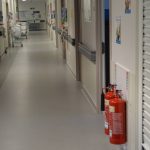 THINK SAFE WHEN FIRE BREAKS OUT
THINK SAFE WHEN FIRE BREAKS OUT
A summer evening in Ward B11 at Forth Valley Royal Hospital. Advanced nurse practitioner Stewart McNaughton, a member of the hospital at night team, had just reviewed a patient and was at the nursing station writing up notes. Suddenly the fire alarm sounded. Stewart saw nurses escorting a patient from a room and dashed along to find socks and papers alight. Together with another nurse they grabbed a fire extinguisher .
“The smoke and smell were probably the worst but it was all over in a few minutes” explained Stewart. “I have had fire training within the NHS and some years ago undertook practical training at Alloa Fire Station which included using fire extinguishers. I think it’s really important to know what to do in situations like this. You never know when fire might break out and being able to react immediately is crucial especially where vulnerable patients are concerned.”
This experience highlights an incident which has happened on a number of occasions in recent years. It illustrates that fire does not come by appointment. Thankfully on this occasion trained staff using the appropriate fire extinguishers were able to save the day.
NHS Forth Valley employs two Fire Safety Advisers – Eddie Hattie and Alan McGeachie. Alan says the risk of fire in all NHS premises is ever present. Fire training is delivered in stages starting with induction into local fire safety awareness and procedures. Staff should be familiar with fire exits, where fire extinguishers are and local evacuation procedures. The next stage is using Learn-Pro to accumulate further skills.
“On a scale of 1 to 10 I would say it’s 10 for knowing what to do in the event of a fire alert. We also do practical fire extinguisher training using a state of the art digital fire simulator where you can play the role of firefighter. Remember, an immediate response is key to minimising damage and possibly saving lives.”
Marking European Health and Safety Week in Forth Valley
To coincide with this year’s European Health and Safety Week, the NHS Forth Valley Health and Safety team will visit every department (132 departments / teams as listed within our eRSM system) to deliver a management pack (including work related stress information) which has been developed specifically to raise the profile and focus on health and safety across the organisation. Information will also be available on the staff intranet
http://staffnet.fv.scot.nhs.uk/index.php/a-z/risk-management/european-safety-week-2015k/
A number of displays and information sessions are also being held during the week beginning October 19th 2015
|
Day |
Dining Room FVRH |
Front Door Foyer FVRH
|
| Topics | ||
|
Monday 19th Oct |
Stress Management / Health Promotion |
Stress Management |
|
Tuesday 20th Oct |
H&S Management / Occupational Health
|
Fire Safety |
|
Wednesday 21st Oct |
Stress Management
|
N/A |
|
Thursday 22nd Oct |
H&S Management / Occupational Health
|
Health Promotion |
|
Friday 23rd Oct |
Stress Management
|
Slips, Trips and Falls |
